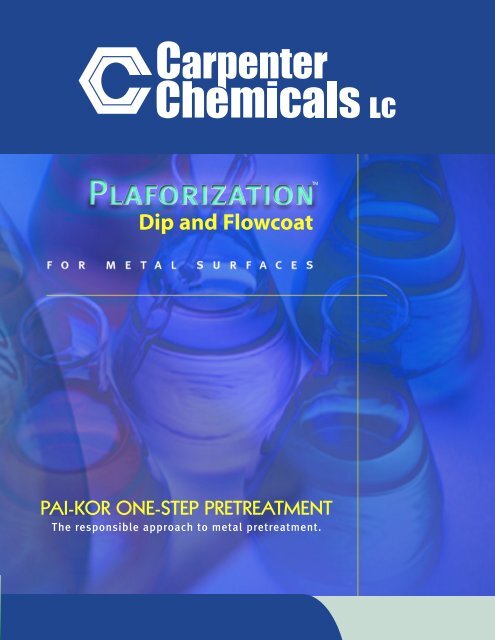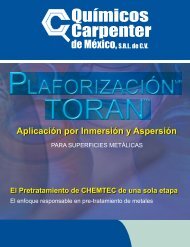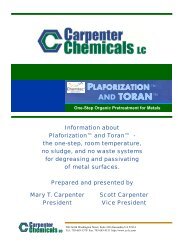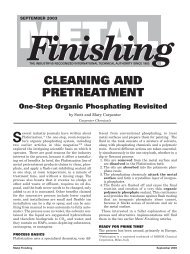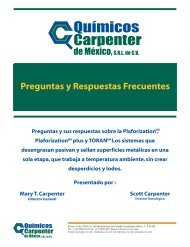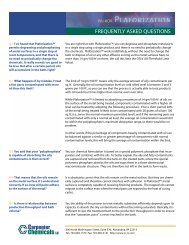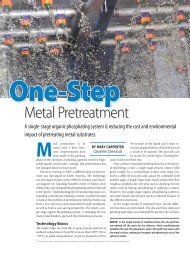Brochure - Carpenter Chemicals
Brochure - Carpenter Chemicals
Brochure - Carpenter Chemicals
Create successful ePaper yourself
Turn your PDF publications into a flip-book with our unique Google optimized e-Paper software.
Dip and Flowcoat<br />
PAI-KOR ONE-STEP PRETREATMENT<br />
The responsible approach to metal pretreatment.
Plaforization . . .<br />
✦ One treatment stage<br />
As easy as it gets!<br />
Only one tank: Plaforization cleans, phosphatizes and seals in a single step.<br />
There is no rinsing, so the part is ready for painting or storage as soon as it is dry .<br />
Clean and phosphate at the same time: The parts are cleaned by dipping or<br />
flowcoating for one minute. During treatment, the metal surface is converted and<br />
both a metal phosphate and a continuous polymer sealant are simultaneously<br />
applied to the surface.<br />
Treat various metals at the same time: Steel, galvanized steel, aluminum,<br />
cast iron; in fact, most metals, except alloys containing silicon.<br />
✦ Operates at<br />
room temperature<br />
✦ Creates no effluent,<br />
no solid waste<br />
Stop heating your bath and eliminate your natural gas bill. Because Plaforization <br />
works at room temperature, you also don’t waste time waiting for warm-up of the<br />
solution. Plaforization is ideally suited for both batch and continuous production.<br />
Since no water is used, there is no water disposal or treatment, and therefore no<br />
disposal permits are required. Plaforization also creates no sludge, so you have<br />
no solid waste disposal to worry about either.<br />
✦ Flash rust protection<br />
✦ Never change the<br />
treating solution<br />
✦ Environmentally and<br />
worker friendly<br />
✦ Low capital and<br />
operating cost<br />
✦ Operation is simple<br />
The polymer that is part of the phosphate coating serves two purposes. First, it<br />
absorbs oils and greases removed from the part and by a chemical change these<br />
become part of the polymer. When the polymer film is formed it actually seals the<br />
phosphate so that the pretreated parts will resist corrosion for weeks without<br />
painting if stored indoors.<br />
Never change the treating solution, because the polymer chemically captures the<br />
oil and the continuous filter system removes dirt. All you need to do is top off the<br />
liquid as it is consumed.<br />
The Plaforization solution is environmentally friendly and worker friendly. Due to<br />
its extremely low vapor pressure, it is virtually VOC-free.* Plaforization contains<br />
no chlorinated fluorinated compounds (CFCs), hazardous air pollutants (HAPs),<br />
halogen-containing hydrocarbons (HHCs), aromatics, chrome, or ozone-depleting<br />
substances. The vapor decomposes in air to carbon dioxide and water in a few<br />
days. *Except in SCAQMD.<br />
The plant is compact and simple to operate, keeping the capital and operating<br />
costs low. An efficient installation will have a payback period of between 1 and 2<br />
years. No daily bath analyses are necessary, just a free analysis every other month<br />
by our certified laboratories. Because there is no heating, no rinsing and no effluent,<br />
the costs of a Plaforization installation are much less than for a conventional<br />
multi-tank heated system. Because this process requires only a single stage, the<br />
amount of space required is also less. There is no messy tank cleaning. And you<br />
need no chemical knowledge to operate with Plaforization .<br />
Treated parts are first wetted by the Plaforization solution for 60 seconds, then<br />
dried, and are ready to paint. One gallon treats 1,200 to 1,600 sq. ft.
I N S T A L L A T I O N S<br />
Compared with a conventional multi-stage system, a Plaforization installation is simple. Only one tank is needed<br />
and the process works at ambient temperature. In a dip system, tank size is determined by the largest part to be treated<br />
and, in the case of a plant fed by a continuous overhead conveyor, by the speed of the conveyor. In a flowcoat system,<br />
tank size is determined by line speed, number of nozzles and amount of metal to be treated.<br />
Manual and Semi-automatic Installations<br />
Because there is no heating, just remove the tank cover, start the<br />
pump-filter and the plant is ready for operation. An exhaust panel<br />
at the back of the tank removes any solvent vapors from the plant.<br />
EXHAUST<br />
LIQUID<br />
LEVEL<br />
REMOVABLE COVER<br />
ADJUSTABLE<br />
EXHAUST SLOTS<br />
FILTER<br />
TANK<br />
EDUCTORS<br />
PUMP FOR EDUCTORS<br />
AND FILTRATION<br />
<br />
Continuous Automatic Plants<br />
PAI-KOR ONE-STEP PRETREATMENT<br />
the responsible approach to metal pretreatment<br />
BLOW-OFF<br />
AREA<br />
TOP OF<br />
OPENING<br />
FLUID<br />
LEVEL<br />
CONVEYOR<br />
BOTTOM OF<br />
OPENING<br />
FILTER<br />
For a dip process<br />
Parts are hung from the overhead conveyor and proceed<br />
through the Plaforization tank, through a drainage and<br />
blow-off zone, through the drying oven and then directly into<br />
the painting booth and through the curing oven.<br />
PUMP<br />
PROFILES<br />
FLOWCOAT<br />
For a flowcoat process<br />
Parts are hung from the overhead conveyor, proceed through the<br />
spray chamber, then to a drainage and blow-off zone and into a<br />
warm drying oven, then directly to painting and the curing oven.<br />
EXIT<br />
ENTRY<br />
AIR BLOW-OFF<br />
PUMP<br />
FILTER<br />
TANK
PRODUCT RANGE<br />
Plaforization is offered in a range of products<br />
designed to meet various industrial needs.<br />
For example, some users have intermittent or flexible production and can<br />
air-dry their parts, while others will want to oven-dry them. Some users may<br />
want to recover and recycle the fluids, generally for regulatory reasons or<br />
because of high production levels. Products are available with a flashpoint<br />
above 200 degrees F. And there is also a special line for those desiring high salt<br />
spray resistance of pretreated but unpainted parts.<br />
“I couldn’t be in the powder coating business without Plaforization .”<br />
JAY JOHNSTON, President<br />
Johnston Metal Works, Inc.<br />
Cheboygan, MI<br />
“Best of all, we have seen a great reduction in...part rejections due to<br />
adhesion problems..., as well as major improvements in the quality of<br />
our powder coat paint finishes..”<br />
JIM GALVIN, Owner<br />
Total Automation, Inc.<br />
Columbia Station, OH<br />
“We thought this would be a good return on our investment, with the<br />
quality of cleaning as well as the environmental benefits. No water is<br />
needed. No heat is needed. There’s no waste. That’s the key.”<br />
CONNIE DAVIDSON, General Manager<br />
North Country Wind Bells<br />
Round Pond, ME<br />
“Ecophor A447 has performed well, meeting or exceeding our<br />
required performance specifications.”<br />
MATT BOTTER, Senior Project Engineer<br />
General Dynamics Ordnance and Tactical Systems<br />
Garland, TX<br />
For more information contact:<br />
<strong>Carpenter</strong> <strong>Chemicals</strong>, LC<br />
Suite 330<br />
206 North Washington Street<br />
Alexandria, VA 22314<br />
Tel.: 866-683-1570 (toll free)<br />
703 683-1570<br />
Fax: 703 683-4131<br />
e-mail: info@cc-lc.com<br />
web: www.cc-lc.com<br />
“The village where our business is located currently has no sanitary<br />
sewer, so disposal of a cleaning material created a real problem for us.<br />
[Plaforization ] has enabled us to eliminate all of the disposal<br />
headache and expense. We started using Plaforization in June 2003,<br />
and it has performed very well for us.”<br />
DALE VAN DYK, President<br />
Smart Manufacturing Group<br />
Schoolcraft, MI


